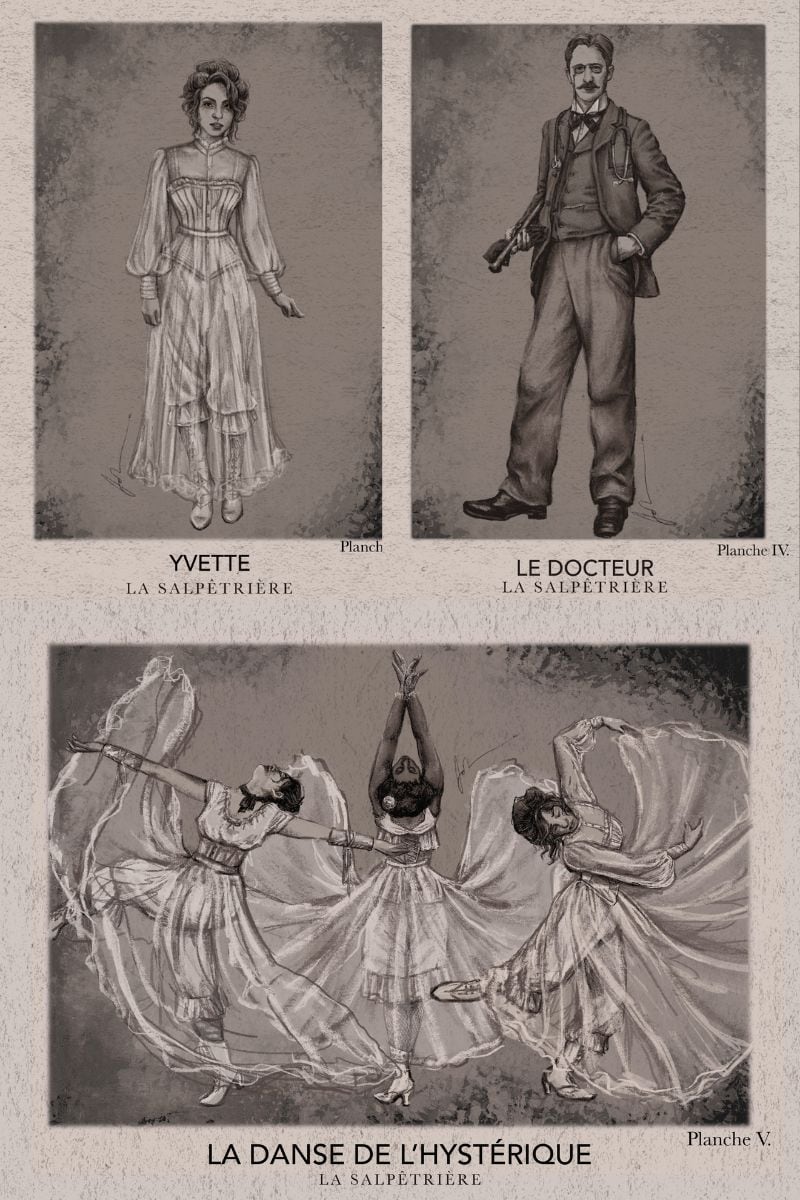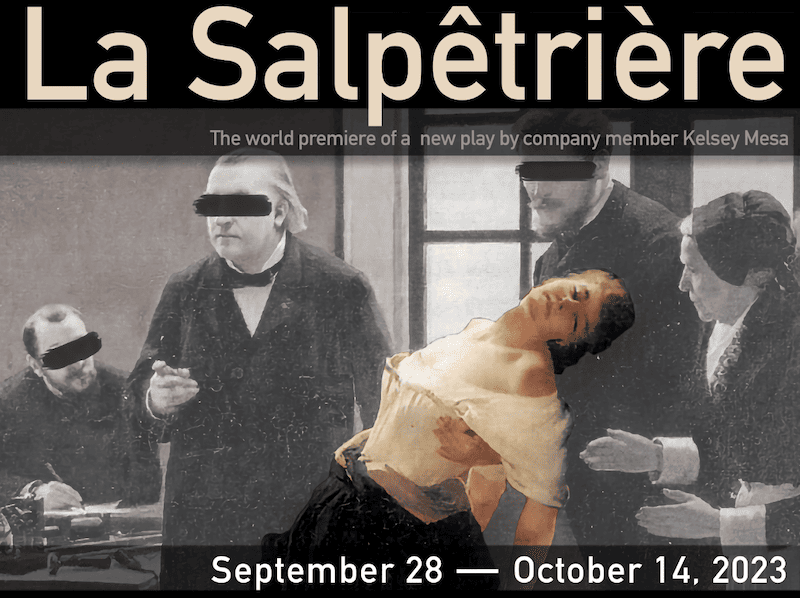Picture this: Three women, described as “hysterics,” dominate the stage. Two of them do a mad dance around the other, who is lying prone at their feet.
That scene is the prologue of La Salpêtrière, a new play written by Kelsey Mesa and produced by Taffety Punk, the remarkable theater company housed at Capitol Hill Arts Workshop. It sets the stage, literally, for a drama that veers from dreamlike acceptance of the grotesque to nightmarish demonstrations of hypnosis, used here as a weapon to manipulate, entertain, and destroy.

If this sounds like a scene from hell, peopled by demons in suits, you’d be partly correct. But the demons are doctors—chief among them a neurologist named Jean-Martin Charcot—and the women are patients, confined, and then treated, for exhibiting questionable behavior.
The woman on the floor is Yvette, a newcomer to the asylum, described as a “mouse of a housewife” (Fabiolla da Silva); the dancers are Antoine, a seemingly sophisticated rebel from a wealthy family (Kimberly Gilbert), and Didi, a “model hysteric” and former prostitute (Yihong Chen).
The scene sets the tone for a dark but funny and occasionally raunchy tale of the women’s discovery of the power they possess.
“It’s important to the story that these are just women,” Mesa told me in an interview conducted over lunch at a quiet eatery on Wisconsin Avenue. “The opening moment is deliberately staged, in Director Danielle A. Drakes’ interpretation, to be strange and ridiculous.”
And “strange and ridiculous” is a good way to describe the way the doctor (male) perceives the patients (female). “In the play, these women are condemned for not meeting male expectations. Their treatment is akin to ‘gaslighting’—making them believe a falsehood is true—and it forces them to question their own reality.”
The medical misogynist, Le Docteur (Danny Puente Cackley) is described as the “ringmaster.” He wields hypnosis as a whip. And the patients, docile at first, do his bidding.

La Salpêtrière is Mesa’s first full-length play. “Or rather, it’s the first play I’ve finished,” she laughed. Over the years, she explained, she has often started writing, then put the work aside, in order to focus on directing—at Taffety Punk for 11 years—and on her day job, managing the Kennedy Center American College Theater Festival. Now 37, she joined the Kennedy Center right out of college at Northwestern.
However, the days of directing and management came to a halt when the pandemic struck. The world went into lockdown. “Suddenly, I was stuck at home and able to read a lot,” she said.
One of the books that stunned her most—and that led to writing this play—was Trainwreck: The Women We Love to Hate, Mock, and Fear … and Why by Sady Doyle.
“I read the chapter on Hysteria and went into a state of shock,” she said. The book described conditions at La Salpêtrière (pronounced sahl-PET-ree-AIRE)—a prison-like hospital for the poor in Paris—where Charcot, the doctor who ran the neurology clinic, believed in punching women in the ovaries as a treatment.
“Charcot used hypnosis to treat hysteria. He actually invited the public to attend—and watch his demonstrations of manipulation—as entertainment!” Mesa added, shaking her head in disbelief.
“History fascinates me,” she went on, describing the “real” Salpêtrière.
Originally built as a gunpowder factory, it was converted by Louis XIV into a prison, then evolved into a charity hospital in which all the cast-offs—the elderly, the weak, the wanton, and the insane—were lumped together. When a mob attacked the place, during the French Revolution, they freed the prostitutes but murdered the mentally ill.

Under Charcot’s leadership, the hospital pivoted toward the treatment of hysteria. (Ironically, the institution still exists, though in very different form. Called La Pitié-Salpêtrière, it is now part of the Sorbonne, and is where luminaries such as Josephine Baker and Princess Diana both died.)
Sigmund Freud was one of Charcot’s followers. He did his residency there, and in fact began the practice of psychotherapy by using hypnosis as a treatment for women suffering from hysteria.
“Charcot was a scientist, but his diagnosis and treatment of the women at Salpêtrière was not scientific at all,” Mesa said. “What the doctors and the public called ‘hysteria’ was a catch-all term for many things. Some of these women were mentally ill. Some were tired or opinionated or too lusty for the time. But they were not hysterical!”
A feminist for as long as she can remember, Mesa told me she chose the subject because it was so extraordinary. “It’s obscene but true. The treatment of these women was barbaric. They were treated not as human beings but as objects. Yet their treatment is part of our history.”
“What’s the takeaway?” I asked.
“La Salpetriere is an absurd microcosm of our society,” she replied.
“The hysterics—Yvette, Antoine, and Didi—are trapped inside a world that was created to keep them down; it’s constructed so that they can’t possibly win. Their only option is to play along and follow the doctor’s rules.
“Even when the women can see the world more clearly—and thus try to create a path forward—the path itself is terrifying and unknown.
“I think we all need a reminder to look at the world more clearly,” she continued. “We need to remember that the structure and rules have all been made up. And they’re not for the benefit of everyone.
“However, we still have the power to move forward differently or to create something new. That concept is uncomfortable. It requires hard work, but it’s still worth it to take the next step, as long as we’re moving toward something better.”
Running Time: 90 minutes with no intermission.
La Salpêtrière plays September 28 through October 14, 2023, presented by Taffety Punk Theatre Company performing at the Capitol Hill Arts Workshop, 545 7th Street SE, Washington, DC. Purchase tickets ($15 each, half-price during previews) online.
La Salpêtrière
Playwright: Kelsey Mesa
Director: Danielle A. Drakes
CAST
Kimberly Gilbert (Antoine)
Fabiolla da Silva (Yvette)
Yihong Chen (Didi)
Danny Puente Cackley (Le Docteur)
PRODUCTION
Lighting Design: Elijah Thomas
Costume Design: Johnna Presby
Movement, Fights, and Intimacy Direction: Lorraine Ressegger
Sound Design: Marcus Kyd
Stage Manager: Jenna Keefer





